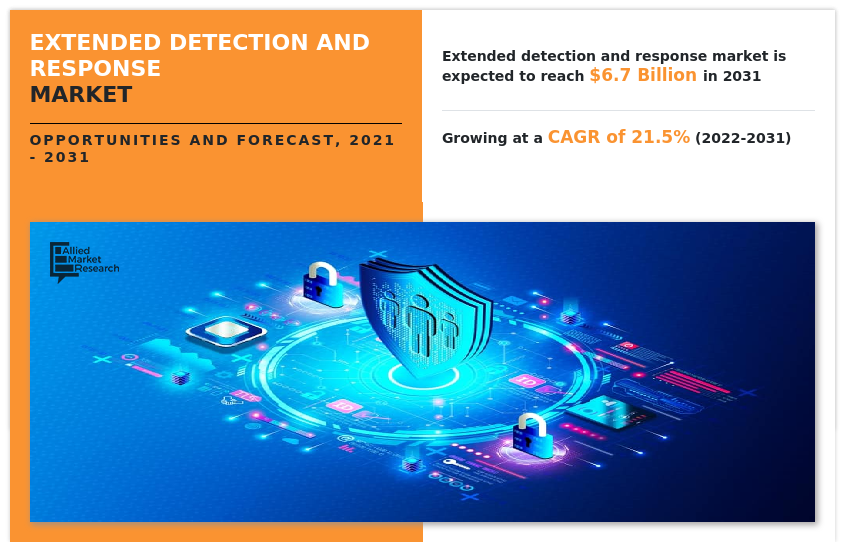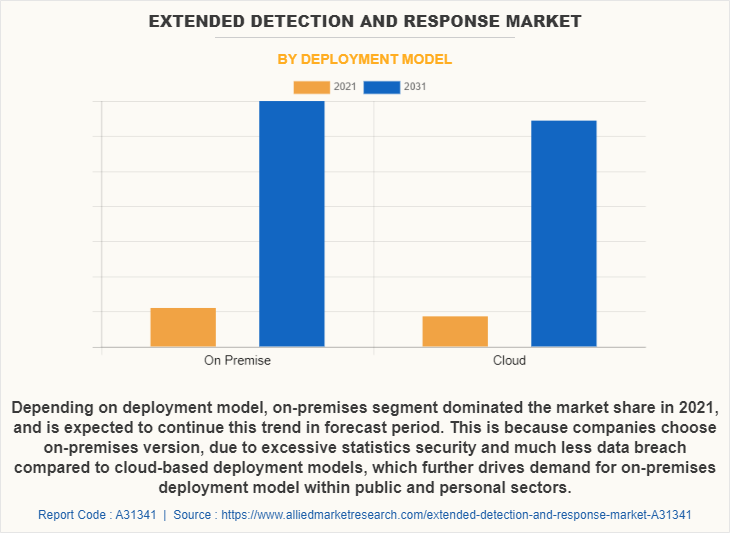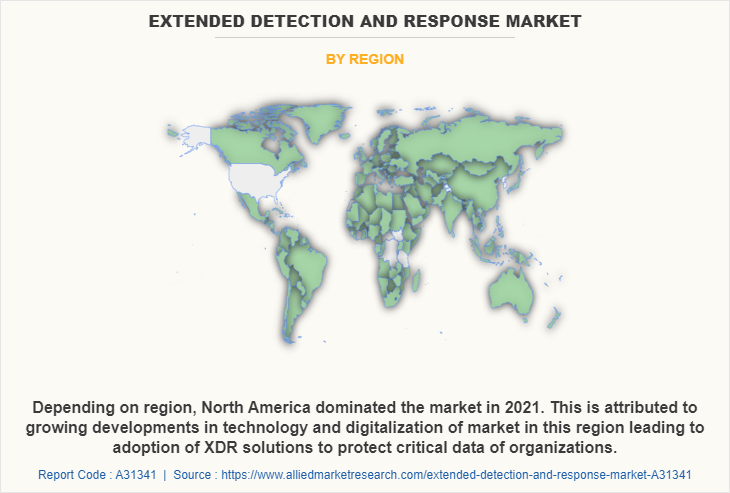Extended Detection and Response Market Insights, 2031
The global extended detection and response market was valued at USD 980.3 million in 2021, and is projected to reach USD 6.7 billion by 2031, growing at a CAGR of 21.5% from 2022 to 2031.
XDR is an integrated suite of safety tool for IT infrastructure that provides comprehensive threat detection, prevention and response across the cloud, networks, endpoints and servers. XDR offer increased simplicity in scanning the integrated devices to scan for breaches. Various enterprises are adopting XDR solutions as it increases SOC efficiency by offering security team with a detailed view of detected threats across different data flows and security tools for instance, firewalls, endpoints detection solutions, network detection platforms and cloud security tools. Moreover, XDR provides automation, prioritization, faster detection and better visibility. These factors provide lucrative opportunities for market growth.

On the basis of component, solutions segment captured the largest Extended Detection and Response Industry share in 2021 and is expected to continue this trend during the forecast period as XDR solutions detects, automates, prevent and shield networks from cyber threats. However, services segmented is expected to witness highest growth in upcoming years since it complements software program implementation, maximize cost of existing installation by optimizing it, and minimizes deployment cost & risks, which further fuels increase of the extended detection and response market.
The global extended detection and response market is segmented on the basis of component, deployment mode, organization size, industry vertical, and region. By component, it is bifurcated into software and services. By deployment mode, it is segregated into cloud and on-premises. By industry vertical, it is segregated into BFSI, retail and e-commerce, manufacturing, government, IT & telecom, healthcare, government, energy and utilities, and others. By organization size it is categorized into small to medium enterprises (SMEs) and large enterprises. Region wise, it is analyzed across North America, Europe, Asia-Pacific, and LAMEA.
On the basis of component, solutions segment captured the largest Extended Detection and Response Industry share in 2021 and is expected to continue this trend during the forecast period as XDR solutions detects, automates, prevent and shield networks from cyber threats. However, services segmented is expected to witness highest growth in upcoming years since it complements software program implementation, maximize cost of existing installation by optimizing it, and minimizes deployment cost & risks, which further fuels increase of the extended detection and response market.
Depending on deployment model, on-premises segment dominated the extended detection and response market share in 2021, and is expected to continue this trend in forecast period. This is because companies choose on-premises version, due to excessive statistics security and much less data breach compared to cloud-based deployment models, which further drives demand for on-premises deployment model within public and personal sectors. However, cloud segment is expected to witness highest growth.

Depending on region, North America dominated the market in 2021. This is attributed to growing developments in technology and digitalization of market in this region leading to adoption of XDR solutions to protect critical data of organizations. However, Asia-Pacific is expected to witness highest growth in upcoming years owing to increased cyber threats and rapid shift towards cloud-based platforms in this region.

Growth drivers, restraints, and opportunities are explained in the report to better understand the market dynamics. This report further highlights key areas of investment. In addition, it includes Porter’s five forces analysis to understand the competitive scenario of the industry and role of each stakeholder. The report features the strategies adopted by key market players to maintain their foothold in the market.
Top Impacting Factors
The key factor impacting the growth of extended detection and response market growth includes evolution of cyber threats. With new technological advancements, new threats are also evolving, which is a concerning factor for various enterprises. Thus, many industries are adopting XDR for secure and automated projects. Moreover, the rising deployment of managed extended detection and response solutions across SMEs also provide lucrative opportunities of market growth. However, the availability of free extended detection and response tools and low budget restraint the market growth.
Cyber threats evolution
As current threats keep growing in complexity, advanced threats inclusive of ransomware and zero-day assaults preserve to boom in volume. To cope with these, agencies look ahead to adopting XDR that's a proactive method that consists of prevention, detection, and reaction.
Threat tracking and cyber protection are of paramount significance within the swiftly converting threat landscape. The increased dangers of cyberattacks has created numerous demanding situations in securing essential information. With the developing revolution of cybercrimes, organizations are moving towards using XDR solutions as they offer superior risk detection and deep visibility throughout networks, endpoint devices, and clouds. XDR conveys the idea of risk detection and reaction across more than one protection controls – each endpoints and networks. A strong XDR answer combines risk information collectively and dynamically detects through analytical methodologies, investigate, and confirm threat’s validity prior to initiating a reaction. Organizations are deploying a number of advanced XDR for unified and complete visibility of the risk landscape.
Impact of COVID-19
The extended detection and response market size was valued at $1167.49 million in 2022, and is projected to reach $ 6722.67 million by 2031, registering a CAGR of 21.5%. COVID -19 outbreak has significantly impacted the extended detection and response market. The global COVID-19 pandemic has drastically affected businesses across the world. It has positively impacted adoption of extended detection and response (XDR), owing to increased cyber threats. With increasing trend of WFH, the need to use managed security and XDR has increased eventually.
Nowadays companies are focusing on emerging technology such as Al-powered solutions, automation, computing technology, and cloud-based endpoint detection and response across industries such as BFSI, healthcare, and government to perform contactless operation, with safely and securely. This factor creates demand for XDR solution, thus drive adoption of the extended detection and response market globally. Moreover, local enterprises have been increasingly adopting XDR solutions and services to make their operations scalable, efficient and secure. Furthermore, industries move toward digitalization creates demand for robust and Al-integrated XDR solutions to provide agile efficiency and real-time reporting features. Such benefits provide lucrative growth opportunities for the market growth during the forecast period.
Key Benefits For Stakeholders
- This report provides a quantitative analysis of the Extended Detection and Response Market Forecast, current trends, estimations, and dynamics of the extended detection and response market analysis from 2021 to 2031 to identify the prevailing extended detection and response market opportunities.
- The market research is offered along with information related to key drivers, restraints, and opportunities.
- Porter's five forces analysis highlights the potency of buyers and suppliers to enable stakeholders make profit-oriented business decisions and strengthen their supplier-buyer network.
- In-depth analysis of the extended detection and response market segmentation assists to determine the prevailing market opportunities.
- Major countries in each region are mapped according to their revenue contribution to the global extended detection and response market.
- Market player positioning facilitates benchmarking and provides a clear understanding of the present position of the market players.
- The report includes the analysis of the regional as well as global extended detection and response market trends, key players, market segments, application areas, and market growth strategies.
Extended Detection and Response Market Report Highlights
| Aspects | Details |
| By Component |
|
| By Deployment Model |
|
| By Enterprise Size |
|
| By Industry Vertical |
|
| By Region |
|
| Key Market Players | BitDefender, BlueShift Technologies, Trend Micro Inc, .IBM CORPORATION, Elastic Inc., SentinelOne, Confluera, Fortinet Inc., Cynet, Palo Alto Networks Inc, Microsoft Corporation, Broadcom Corp, Cisco Systems Inc., Sophos Group, Crowstrike, McAfee |
Analyst Review
According to CXOs of leading companies, enterprises have witnessed various changes in business processes, operations, and industrial automation. Moreover, organizations are increasingly shifting toward cloud-based operations and digitalization to muddle through rising cyber threats and competition. Protection of confidential data amid rise in incidences of cyberattacks have been the most intriguing challenges for enterprises. Extended integration of numerous software program answers with current structures and heightened complexities in handling more than one signals with restricted context approximately the growing range of safety threats purpose safety groups to lose visibility, hampering enterprise operations. The situation has caused the development of XDR technology, which makes use of dynamic analytics and device gaining knowledge of strategies to offer prolonged visibility, investigation, and response throughout clouds, networks, and endpoints. Furthermore, increased investments in the extended detection and response market propels the market growth further.
For instance, in April 2022, Bitdefender launched a native XDR solution named as GravityZone XDR, which is designed to offer rich protection context, correlation of disparate alerts, and out-of-the-box analytics. The product has functions that include speedy cross-correlation hazard detection, automatic risk identification & prioritization, and recommended risk response actions.
The global extended detection and response market was valued at $980.26 million in 2021 and is projected to reach at $6722.67million by 2031
The extended detection and response market is projected to grow at a compound annual growth rate of 21.5% from 2021 to 2031.
The market players operating in the extended detection and response market includes Bitdefender, Blueshift, Broadcom, Cisco, Confluera, Crowstrike, Cynet, Elastic, Fortinet, IBM, Sophos, McAfee llc, Microsoft, Palo Alto Networks, SentinelOne, and Trend Micro. These major players have adopted various key development strategies such as business expansion, new product launches, acquisitions and partnerships, which drive the growth of extended detection and response market globally.
Depending on region, North America dominated the market in 2021. However, Asia-Pacific is expected to witness significant growth in the coming years
The key factor impacting the growth of extended detection and response market includes evolution of cyber threats. With new technological advancements, new threats are also evolving, which is a concerning factor for various enterprises. Thus, many industries are adopting XDR for secure and automated projects. Moreover, the rising deployment of managed extended detection and response solutions across SMEs also provide lucrative opportunities of market growth. However, the availability of free extended detection and response tools and low budget restraint the market growth.
Loading Table Of Content...



